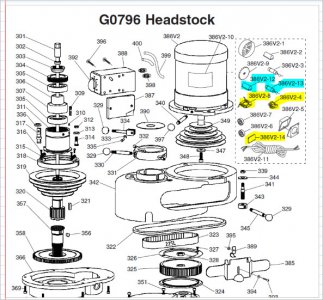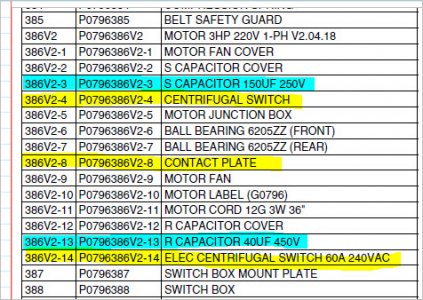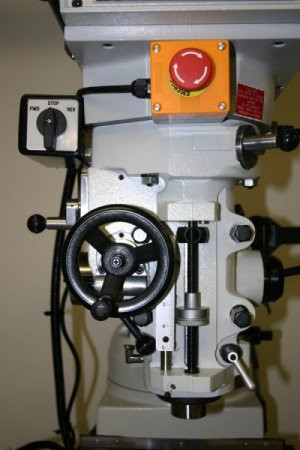-
Welcome back Guest! Did you know you can mentor other members here at H-M? If not, please check out our Relaunch of Hobby Machinist Mentoring Program!
You are using an out of date browser. It may not display this or other websites correctly.
You should upgrade or use an alternative browser.
You should upgrade or use an alternative browser.
Mill capacitor centrifugal switch issue?
- Thread starter petertha
- Start date
Now do you mean the main Fwd/Off/Rev switch box (upper left) or the centrifugal switch inside the motor can?
No that is the power switch. The capacitor switch is inside the motor and disengages when the motor is at a preset RPM.
I recognize the Grizzly G0796 is a completely different mill to mine so apples & oranges motor wise too. I'm envious of their parts detail which strangely I still cant seem to locate for my motor despite it 'appears' to be a well known industrial name. What I was wondering out loud, is it reasonable to expect the centrifugal switch assembly to be located deeper in the motor, like beneath the rotor assembly - versus on the top side with the fan cover off?
I'm reading some not-so-good articles about start circuit windings potentially being damaged as a result of a failed centrifugal switch. Can the windings be tested in-situ for that? I guess all this will be revealed once the pro arrives, but just wondering out loud.


I'm reading some not-so-good articles about start circuit windings potentially being damaged as a result of a failed centrifugal switch. Can the windings be tested in-situ for that? I guess all this will be revealed once the pro arrives, but just wondering out loud.


- Joined
- Apr 30, 2015
- Messages
- 12,157
The switch is within the motor case- replace the start cap and see if that takes care of the problem. If not the warranty should cover motor repair or replacement
mark
mark
Success. At least so far so good. The starting capacitor was replaced with the exact same model / part number / spec. All the wiring & connections were checked over from outlet plug through CSA box. Centrifugal switch is located near top of motor by removing cover plate, then plastic fan, its under there. Contacts looked pristine, open/close conductivity checked, wiring terminal nice & tight. De-gunked the slight leakage form blown cap. The blue tape job over the wire was just wrapped over a legitimate connector plug underneath, so wasn't a bad thing after all.
Flicked the switch & away she ran. No more gravely, cogging sound. Ran it for several minutes through speed ranges, repeated on/off & fwd/rev. Yay! So not sure if it was a dud capacitor to begin with and/or or my under-amped breaker flicking off was somehow aggravating it. But I hope this is behind me now.
Technician provided a tip that on these kinds of motors you should not flick the switch on & off quickly. Not that can think of a good reason to ever do this but the point is to allow the centrifugal switch do its job uninterrupted. That's the audible click you hear shortly after starting, it happens in a blink if everything is working properly. Another comment was look for any sign of corrosion on things like contacts & terminals. Sometimes between storage & the ocean journey over this can happen.
Thanks to all who helped. I look forward to more machining & less diagnosis & remediation!
Flicked the switch & away she ran. No more gravely, cogging sound. Ran it for several minutes through speed ranges, repeated on/off & fwd/rev. Yay! So not sure if it was a dud capacitor to begin with and/or or my under-amped breaker flicking off was somehow aggravating it. But I hope this is behind me now.
Technician provided a tip that on these kinds of motors you should not flick the switch on & off quickly. Not that can think of a good reason to ever do this but the point is to allow the centrifugal switch do its job uninterrupted. That's the audible click you hear shortly after starting, it happens in a blink if everything is working properly. Another comment was look for any sign of corrosion on things like contacts & terminals. Sometimes between storage & the ocean journey over this can happen.
Thanks to all who helped. I look forward to more machining & less diagnosis & remediation!
- Joined
- Nov 13, 2018
- Messages
- 83
MY 20 cents worth.
Your motor, 2.2kw @ 220, about 10 amps.
A circuit breaker is to protect your wiring, cabling in the building. A normal domestic C curve circuit breaker...well read this....
http://www.quantumautomation.com/blog/c-vs-d-curve-circuit-breakers-whats-the-difference
If you wish for motor protection, you need to provide that for each individual motor., which also, accounts for start up current x time automatically. either thermal or electronic. If your mcb was still 15A, I wouldn't worry about it. But with the 40 Amp bugger, you have no motor protection at all.
Your motor, 2.2kw @ 220, about 10 amps.
A circuit breaker is to protect your wiring, cabling in the building. A normal domestic C curve circuit breaker...well read this....
http://www.quantumautomation.com/blog/c-vs-d-curve-circuit-breakers-whats-the-difference
If you wish for motor protection, you need to provide that for each individual motor., which also, accounts for start up current x time automatically. either thermal or electronic. If your mcb was still 15A, I wouldn't worry about it. But with the 40 Amp bugger, you have no motor protection at all.
My understanding is the yellow reset switch box thingy shown in post #9 is the requisite CSA combination thermal / current overload protection that the re-seller must install to make it compliant. CSA = Canadian Standards Association (electrical). Beyond that I'm not sure how it works internally but I did notice it was also clicking off when the 15A breakers tripped. So I think that box prevents the scenario you are mentioning where the motor could draw the full line amps.
As mentioned, a 15A main panel breaker does me no good if the 20A FLA motor draws say 25 or 30A even for a brief instant at the beginning of every start. Either I was just on the bubble of it even allowing a start, or it had entirely to do with capacitor, or the issues were kind of aggravating one another I cant say. If I'm off base on any of this let me know, that's the purpose of sharing & learning.
As mentioned, a 15A main panel breaker does me no good if the 20A FLA motor draws say 25 or 30A even for a brief instant at the beginning of every start. Either I was just on the bubble of it even allowing a start, or it had entirely to do with capacitor, or the issues were kind of aggravating one another I cant say. If I'm off base on any of this let me know, that's the purpose of sharing & learning.
- Joined
- Nov 13, 2018
- Messages
- 83
An MCB has a time delay curve for any given current. The normal start up time is what, <1 second at possibly a tad > 30 amps, on a 15amp MCB, should be OK.
Technical, but explains what is going on.
The full load current of your motor when working will maybe approach 15 amps, but would need to be stalled to go above it.
But look, if you are game, leave the 40amp MCB in there. It is no skin of my nose.
This all about what I'd do. An of course, I have never made a mistake in my life. ( Typing with stub of 1 finger)
Thing is, it seems you are up and running. So start making some some chips mate.
And Yes, like all the safety blokes, glasses condoms, gloves and everything. Pain in the bloody arse, I reckon. But shoot, a parachute would be nice at 40,000' when the plane blows up?
The full load current of your motor when working will maybe approach 15 amps, but would need to be stalled to go above it.
But look, if you are game, leave the 40amp MCB in there. It is no skin of my nose.
This all about what I'd do. An of course, I have never made a mistake in my life. ( Typing with stub of 1 finger)
Thing is, it seems you are up and running. So start making some some chips mate.
And Yes, like all the safety blokes, glasses condoms, gloves and everything. Pain in the bloody arse, I reckon. But shoot, a parachute would be nice at 40,000' when the plane blows up?
I wish I understood electrons better but I don't. Now that its up & running running, I have a clamp meter I believe can be set to record maximum as well as continuous. I'll flip the switch & convey what it reads.

